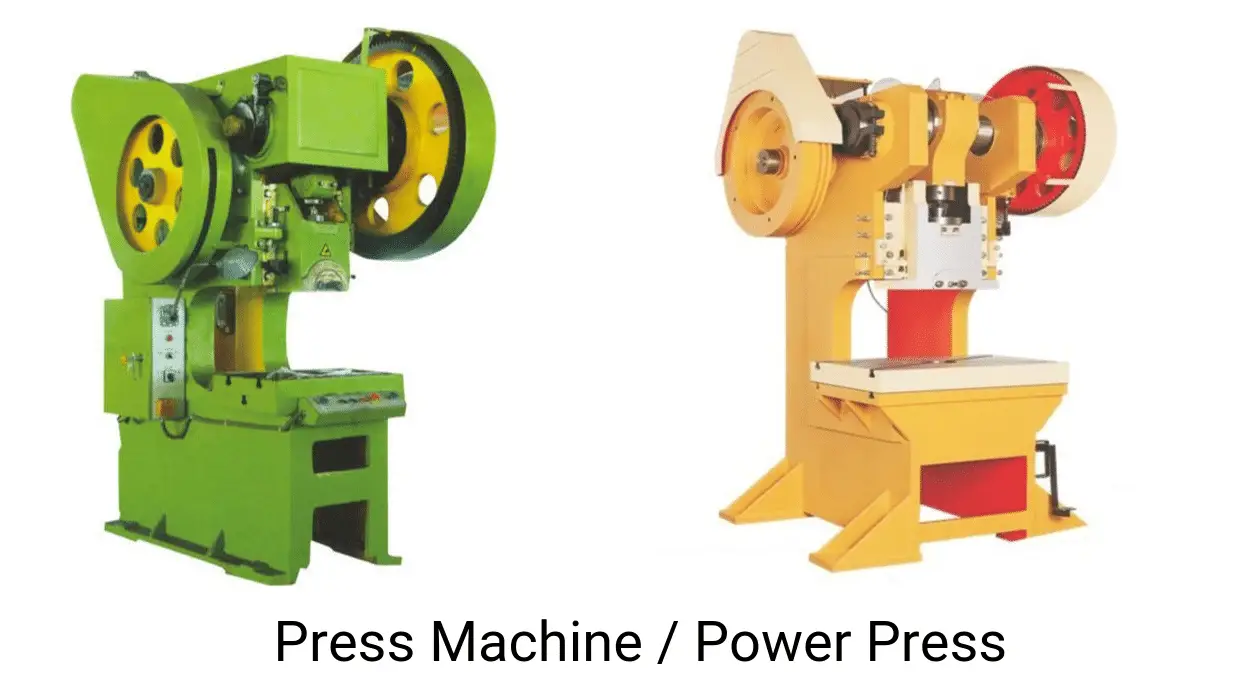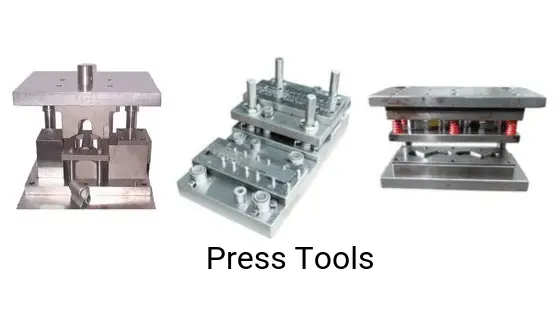Today we are surrounded by sheet metal objects like automotive parts, Car body, Disk-Brake, Gaskets, Door/ window hardware, Electronic appliances components, and cabinets, coins, Cooking, or serving utensils i.e. plate, spoons, glasses, etc. Almost every sheet metal product is made by Metal Stamping.
What is the Sheet Metal Stamping Process?
As per Wikipedia
Sheet Metal stamping (also known as pressing) is the process of placing flat sheet metal in either blank or coil form into a stamping press where a tool and die surface forms the metal into a net shape.
In simple words, we can understand it as
Sheet Metal Stamping or Cold Stamping is a Manufacturing process to produce the desired product from a flat metal sheet by a stamping press. Sheet Metal Stamping Process is also known as the cold Stamping Process.

When the requirement of components exceeds 50,000 pieces, the product design engineer should consider the possibility to manufacture through sheet metal stamping due to its high degree of possible precision, high productivity, utilization of unskilled manpower, and a resultant reduction in weight and cost.
Advantages of Sheet Metal Stamping Process
The metal stamping Process is a modern & advanced technique of manufacturing. The sheet Metal Stamping process has the following benefits or advantages :
- Less weight of stamped components.
- High Volume – Low-cost Production.
- High Efficiency of labor ( Upto 25000 to 40000 stamped parts per 8-hour shift ).
- A high degree of possible precision.
- Low-cost material.
- Uniformity of parts.
- Both complex and simple components such as washers, tanks, a cage of ball bearing & car body parts can be produced very easily.
All the above benefits have made the metal stamping a prime manufacturing process in various industries such as automotive, electrical & electronics, aircraft, and many more.
Metal Stamping Process Equipments
Sheet Metal Stamping Process is impossible without the below-mentioned machines :
- Press Machine / Power Press
- Press Tools / Dies
Note: “A lot of people think that Press Machine and Press Tool is the same thing. Here I must clarify that Press machine and press tools both are different things. Press Tools are the replaceable attachment of press Machines. The same press machine may produce different products but press tools are designed to produce a specific product.”
Press Machine or Power press
A Press Machine or Power Press is a modern-day hammer that generates and applies pressure to a press tool to deform metal sheet into a net desired shape.

Image source: indiamart.com
Power Press Classification
Power presses are classified in various ways. They may be classified according to:
- Source of Power: Mechanical and Hydraulic Press
- Type of frame: Open frame and closed frame press
- No. of slides: Single, double and triple action press
Source of Power: Mechanical and Hydraulic Press
The two main sources of power for applying the force to slide of the press are Mechanical Press and Hydraulic Press.
Mechanical Press Vs Hydraulic Press
In Mechanical Presses, the linear movement of RAM is obtained by a heavy fly-wheel. The heavy flywheel continuously absorbs the energy from an electric motor and delivers it to the ram and hence to the workpiece steadily. Mechanical presses have the following advantages over hydraulic presses:
- Lower Maintenance Cost
- Lower Capital cost
- Run faster
In Hydraulic Presses, the linear movement of RAM is obtained by a hydraulic system. Hydraulic presses are a large cylinder and piston arrangement coupled to a hydraulic pump. The piston and press ram is one unit. The ram is moved by oil pressure on the piston in the cylinder. Hydraulic Presses have several advantages:
- Easier to operate
- Most Versatile
- Tonnage capacity adjustment from zero to maximum
- Constant pressure throughout the stroke
- More powerful than mechanical presses
- Safer than the mechanical press, it will stop to a pressure setting.
Note: Hydraulic presses are slower than mechanical presses.
Type of frame: Open frame and closed frame press
Open frame Vs Closed frame Press
Due to their construction, there are two types of presses: the open frame and closed frame presses. Open frame presses are less strong and less rigid so they are useful for smaller work operations. These presses are available up to 200-tonne capacity and 90 to 140 strokes per minute.
Closed frame presses are highly strong, balanced, and rigid presses for use in bigger work operations. These presses are available up to 3000-tonne capacity.
Note: Closed frame presses often have an inclined press frame that allows removal of the stamped part by gravity.
No. of slides: Single, double and triple action press
Single, Double & Triple action Press
According to the no. of slides, there are single, double, and triple action presses.
A single-action press has only one ram which acts against a fixed bed.
A Double action press has two slides moving in the same direction to the fixed bed. Both the slides are assembled one in another ( Outer ram and inner ram). These presses are used in deep drawing operations.
A Triple action press has two slides moving in the same direction against the fixed bed as in a double-action press and the third slide moves in an upward direction through the fixed bed.
Press Tools or Dies
As per Wikipedia
Press tools are commonly used in hydraulic, pneumatic, and mechanical presses to produce the sheet metal components in large volumes. Generally, press tools are categorized by the types of operation performed using the tool, such as blanking, piercing, bending, forming, forging, trimming, etc. The press tool will also be specified as a blanking tool, piercing tool, bending tool, etc.
In simple words, Press Tools can be defined as
The press tool ( commonly known as die/ dies) is an assembly of die, punch, punch plate, punch backplate, stripper plate, etc. to produce sheet metal components/ stamped parts. Press Tools are assembled in two sections
- Upper section / Upper shoe
- Lower section /Lower shoe

Types of Press Tools or Dies by the operation
Press tools or dies in the sheet metal stamping process can be classified according to the type of operation/process and method of operation.
The sheet metal Stamping may be divided into two following groups by the type of operation :
- Cutting Operations tools
- Forming Operations tools
Cutting Operations press tools or dies
These dies are used to cut the metal sheet. In cutting operations, the work-piece is stressed beyond its ultimate strength. The stresses cause in the metal by the applied forces will be the shearing stresses. Cutting Operation includes the following main operations:
- Blanking:
Stamping Operation of cutting a flat shape from sheet metal.
- Punching /Piercing:
Cutting operation by which various shape holes are made in sheet metal.
- Notching:
Operation by which Metal pieces are cut from the edge of a sheet, plank or strip.
- Trimming:
Cutting unwanted excess material from the periphery of the previously formed component.
- Shaving:
Operation of removing uneven and rough edges to obtain accurate dimensions of the component.
- Slitting:
Stamping process of making uncompleted holes in components.
Forming Operations Press tools or dies
These die changes the appearance or shape of the blank without removing any stock or scrap. In the forming operations, the work-piece is stressed below its ultimate strength. Forming Operation includes the following important operations:
- Bending:
Process in which flat sheet metal or strip is uniformly strained around a linear axis to make an arch.
- Drawing:
The stamping process of forming a flat metal sheet into a hollow shape by pressing of punch into a die cavity.
- Squeezing:
Application of compressive forces by the metal flows to all portions of the die cavity to form the desired net shape.
Types of Press Tools or Dies by the Method Of Operations
According to these criteria, Press Tools may be divided as follows:
Simple Dies
A single-action press tool performs a single operation for each stroke. This operation may be any cutting or forming operation such as Bending, punching, Blanking or notching, etc.
Compound Dies
In compound press tools, there is two or more cutting operation performed at one station for each stroke. Like washer is made by one stroke by blanking and punching operation simultaneously at one station.
Combination Dies
Combination press tools are those tools by which one cutting operation is performed with one or more forming operations. Unlike compound dies where only cutting operations performed for each stroke at one station.
Progressive Dies
A Progressive tool or follow on tool consisting of a series of stations. At each station a single cutting or forming operation performed on a workpiece during the stroke. Between Stroke, the Metal sheet strip moved to the next station by the feeder action. A Finish workpiece is produced at each stroke of the press. Progressive tools are highly efficient stamping dies as they performed multiple operations in one stroke.
Transfer Dies
In transfer dies the already cut blanks are fed mechanically from one station to another to produce a complete stamped part.
Multiple Dies
Multiple or gang press tools produce two or more workpieces at a single station. Generally, those workpieces are smaller in size.
Hope you all like this article. For any suggestion please comment below. We always appreciate your suggestions.


One Comment